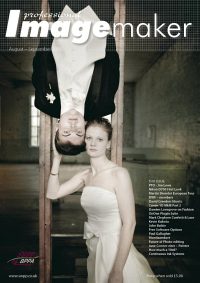articles/Lighting/puttingthedevilintoyourshadows-page2
Lighting For Digital 6 - part 2 of 1 2 3
by Dave Montizambert Published 01/08/2008
A fourth strobe head, placed to the right of the camera, was used to fill in the shadows to ensure some detail, see Image 06 lighting diagram C. A frosted acetate gel was added to its front to even out hotspots. The power of this light was adjusted until an incident meter, with its dome pointed directly at this light and with its back against Terrance's face, read two stops darker (f2.8 @ 1/60th) than the camera's f5.6 @ 1/60th setting. To see the effect of this separation light on Terrance, see Image 07 C.
Still on the topic of fill light values, let's look back at Image 02. Here the fill light was turned up to read 1 stop darker than the camera setting - it read f4 @ 1/60th. Looking back at Image 04, the fill light was turned down to read 3 stops darker than the camera setting, it read f2 @ 1/60th. Keep in mind that when you add in the fill light it will add some exposure to the main-light's mask of light, and so you need to compensate to maintain a correct exposure. For a 1 stop under-fill, notch up the aperture by a 1/2 stop (ie 5.6 becomes 5.6 and 5/10th); 2 stop under fill = aperture a 1/4 stop up; 3 stop under fill = aperture an 1/8th stop up.
You may be wondering why no soft-box was used on the fill light. I kept this light bare and far away so that it would create some 'sparkle' on the flesh in shadow areas such as on his nose and under his shadow side eye. In addition to this, the reflection of a small fill light source on the subject's eyes is easier to hide or retouch away than the larger reflection caused by a larger light source such as a soft-box, umbrella, or scrim. The down side to this technique is, any unwanted shadows cast by this light will have hard-edge shadows which will draw attention. I did have a little of this happening from Terrance's hat casting a shadow on his forehead.
Dynamic Range v Bit Depth
It's a well-known fact that brightening dark shadows in an image during processing can lead to severe brain trauma due to frustration caused by digital banding and noise issues (see Lighting for Digital 5 article in the December 2007/January 2008 issue). It's a less known fact that how much brightening of shadows you can get away is more dependent upon your camera's bit depth rather than its dynamic range. Dynamic range and bit depth are often confused. Dynamic range is the range of tone that can be captured, meaning how far into the whites and how far into the blacks detail is captured. Whereas bit depth describes how many levels of brightness will be used to break down that total range so that the progression of tone looks continuous. Think of a ladder - the height of the ladder is dynamic range and the number of ladder rungs used to step up to the ladders max height represents levels of brightness or bit depth. A higher ladder equals greater dynamic range and a greater number of rungs on that ladder equal, greater bit depth.
You may hear photographers or manufacturers claim that their camera has a 10 stop dynamic range. That camera may well be able to capture information 10 stops down into the shadow, but how usable are those last stops? In a 12-bit capture, after the sixth stop things are pretty sketchy in the banding/noise department and the same for a 14-bit capture below the eighth stop.
Dave Montizambert
Dave Montizambert lectures internationally on lighting, digital photography and Adobe Photoshop. He is also a published author having written two books on lighting and digital photography (publisher Amherst Media) plus numerous magazine articles on these topics in North America and in Europe. Dave also creates Photoshop tutorial CDs & DVDs for www.software-cinema.com.
Dave is available for lectures and workshops in your area and can be reached at montizambert@telus.net
Please Note:
There is more than one page for this Article.
You are currently on page 2 Contact Dave Montizambert
1st Published 01/08/2008
last update 09/12/2022 14:58:24
More Lighting Articles
There are 0 days to get ready for The Society of Photographers Convention and Trade Show at The Novotel London West, Hammersmith ...
which starts on Wednesday 14th January 2026





